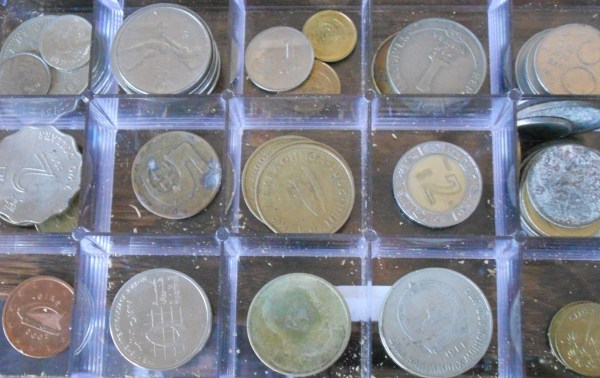
In a small box in my living room I have 51 Austrian schillings, 2300 Italian lira, a couple of thousand Yugoslav dinar and a few Danish coins that look like Polo mints (but are probably worth a lot less). There are many other old coins with varied coatings of rust and dirt; one of these days I may drop them in a glass of Coke in order to restore them to their original glory.
These are valuable travel souvenirs, betraying a lack of precise financial management on my part and now a relic of another time. Who would have thought back in 1987, when I brought a bag full of this unused cash home, that so many of Europe’s coins would become items evoking nostalgia within a couple of decades?
Last year we travelled by train across the continent, visiting 9 countries along the way. Apart from a brief interlude in Switzerland and Liechtenstein, we didn’t need to concern ourselves with exchange rates, with learning a new set of notes and coins, or with trying to work out how to spend the last chunk of money before we left each country. Long gone are the days of Eurocheques, of relying on a two year-old guidebook for exchange rates in countries with rampant inflation, of working out how many drachma you should be getting for your excess Turkish lira quickly enough to avoid being the victim of a common scam.
Unless you’re one of those strange folks who collects coins from different countries and keeps them in a series of neatly divided handicraft boxes designed for buttons, a section for each currency, then you’ll no doubt welcome the arrival of the Euro. One currency, without a confusing and pointless line of zeros on each note, can get you from Calais to Naples and from Paris to Lisbon. And it doesn’t matter if you have a stack of Euros left – they are far more likely to come in handy on your next holiday than a surplus pile of pesetas.
When the men in suits cooked up the single currency all those years ago, its effect on the humble tourist probably didn’t feature high on their list of concerns. Yet in its wake it has created a fundamental change in how we manage money while travelling. For the young German tourist for example, the idea of needing to change money before a Mediterranean beach holiday is an alien concept. And even for Brits, only one foreign currency (the importance of the word ‘foreign’ cannot be understated) is needed to survive in most of the popular holiday destinations.
For those wanting to experience life as it was before the Euro I’d highly recommend a trip in the Balkans. While you’re juggling your Serbian dinar (130 to the £), your Bosnian marks (2.3 to the £), your Croatian kuna (9 to the £) and your Albanian lek (167 to the £) you’ll be sharpening up your mental arithmetic and, if you take the time to study the figures on the bank notes, meeting a few of the national heroes. And if you manage your spending well, you too could come home with enough coins to start a collection that will some day make you smile and bring back memories of your journey.




